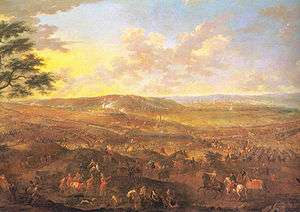Battle of Saragossa
| Battle of Saragossa | |||||||
|---|---|---|---|---|---|---|---|
| Part of the War of the Spanish Succession | |||||||
 An artist's rendition of the Battle of Saragossa, or Monte Torrero | |||||||
| |||||||
| Belligerents | |||||||
|
|
| ||||||
| Commanders and leaders | |||||||
|
|
| ||||||
| Strength | |||||||
| 20,000[1][2] | 30,000[1][2] | ||||||
| Casualties and losses | |||||||
|
5,000 to 6,000 killed or wounded Over 7,000 captured | 1,500 dead or wounded | ||||||
The Battle of Saragossa (Spanish: Zaragoza) took place on 20 August 1710 between the Spanish-Bourbon army commanded by the Marquis de Bay and a multinational army led by the Austrian commander Guido Starhemberg during the War of the Spanish Succession.[1]
Prelude

The 1710 Spanish campaign opened on 15 May when the Spanish Bourbon army commanded by Philip V in person and Francisco Castillo Fajardo, Marquis of Villadarias, took the field for an attack upon the town of Balaguer.[3] The imperial general Guido Starhemberg, commander of the Allied forces in Catalonia, collected his army and cut the thrust by preventing the Spanish army from fording the Segre river, a success in which the officers of the British contingent had a leading role.[4] On June Philip V received reinforcements and made another attempt upon Balaguer with 20.000 infantry and 6.000 cavalry soldiers.[4]
On 27 July 1710 the Spanish army suffered a sharp defeat in the Battle of Almenara, near Balaguer. The allied troops had taken up a strong defensive position and repelled the Spanish attacks until the British commander, James Stanhope, leading the allied vanguard, broke the Spanish lines.[3] Philip V was forced to leave Catalonia and withdraw to Saragossa, the capital of the Kingdom of Aragon. The Castilian Villadarias was afterwards deprived of his rank, which Philip gave to the French general Alexandre Maître, Marquis de Bay.[5]
On 9 August the Spanish army reached Saragossa and the Marquis de Bay positioned his troops between the river Ebro (on his left) and the Torrero heights (on his right). On 15 August, an allied cavalry-attack was successfully countered. Five days of skirmishes followed. On 19 August, the allied troops crossed the Ebro unchallenged and were allowed to deploy their army during the night.[1]
Battle
The allied left-wing was composed of Spanish and Dutch troops under the Count of Atalaya.[1] The right-wing was commanded by Stanhope and was composed of British, Portuguese and Austrian troops.[1] Starhemberg was in charge of the centre, which was mainly German, Austrian and Spanish infantry.[1] The Allied army consisted, in all, of thirty-seven battalions and forty-three squadrons, while the Spanish-Bourbon army was composed of thirty-eight battalions and fifty-four squadrons.[6] On 20 August at 08:00 an artillery-duel started which lasted until noon.
General Stanhope began the attack on the Bourbon-Spanish left wing. At first the Spanish and Walloon troops of the Bourbon army seemed to gain the advantage, having defeated a body of eight Portuguese squadrons, which they chased from the field.[7] This pursuit opened a gap in the Bourbon army lines which gave Stanhope an opportunity of piercing them. The British general put to flight the disorganized Spanish soldiers, while at the centre and the right their attacks were repulsed.[8]
The battle was more or less a repeat of the Battle of Almenara. The cavalry of the Bourbon army attacked fiercely and were almost successful, but the allied troops stood firm. Then the Allies counter-attacked with their infantry and the Spanish army was pushed back.[1] In less than three hours of battle the Allied army won a complete victory.[8] All the artillery (20 cannons) of the Bourbon army and all their colours (73 flags) were seized. Between 5,000 or 6,000 Spanish soldiers were killed or wounded, and another 7,000 were made prisoners. The Allied losses were put as 1,500 men dead or wounded.[9]
Aftermath
Archduke Charles entered Zaragoza the next day. The defeat of the army of Philip V of Spain was severe, the way to Madrid was open.[1] Philip V abandoned Madrid on 9 September and went to Valladolid. Archduke Charles entered a very hostile and almost empty Madrid on 28 September. Charles commented: "This city is a desert!" In the winter of 1710, Archduke Charles and the allied troops had to abandon Madrid, due to the great opposition of the people of Madrid and the dangerous strategic situation. After this, the British army suffered the decisive defeat at the Battle of Brihuega,[10] and the rest of the allied army was defeated at the Battle of Villaviciosa.[10]
Notes
References
- Kamen, Henry. Felipe V, el rey que reinó dos veces. Ediciones Temas de Hoy S.A. Colección: Historia. Madrid (2000) (Spanish)
- Albi, Julio. La Caballería española, un eco de clarines. Tabapress S.A. Madrid (1992) (Spanish)
- Frey, Linda and Marsha (1995). The Treaties of the War of the Spanish Succession: an Historical and Critical Dictionary. Greenwood Publishing Group. ISBN 978-0-313-27884-6.
- Stanhope, Philip Henry. History of the War of the Succession in Spain. London, John Murray (1832).
- Cust, Edward (Sir). Annals of the wars of the eighteenth century: compiled from the most authentic histories of the period, Volume 1. London, Mitchell's military library (1858).
External links
Coordinates: 41°39′00″N 0°53′00″W / 41.6500°N 0.8833°W
